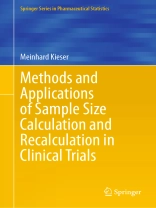This book provides an extensive overview of the principles and methods of sample size calculation and recalculation in clinical trials. Appropriate calculation of the required sample size is crucial for the success of clinical trials. At the same time, a sample size that is too small or too large is problematic due to ethical, scientific, and economic reasons. Therefore, state-of-the art methods are required when planning clinical trials.
Part I describes a general framework for deriving sample size calculation procedures. This enables an understanding of the common principles underlying the numerous methods presented in the following chapters. Part II addresses the fixed sample size design, where the required sample size is determined in the planning stage and is not changed afterwards. It covers sample size calculation methods for superiority, non-inferiority, and equivalence trials, as well as comparisons between two and more than two groups. A wide range of further topics is discussed, including sample size calculation for multiple comparisons, safety assessment, and multi-regional trials. There is often some uncertainty about the assumptions to be made when calculating the sample size upfront. Part III presents methods that allow to modify the initially specified sample size based on new information that becomes available during the ongoing trial. Blinded sample size recalculation procedures for internal pilot study designs are considered, as well as methods for sample size reassessment in adaptive designs that use unblinded data from interim analyses. The application is illustrated using numerous clinical trial examples, and software code implementing the methods is provided.
The book offers theoretical background and practical advice for biostatisticians and clinicians from the pharmaceutical industry and academia who are involved in clinical trials. Covering basic as well as more advanced and recently developed methods, it is suitable forbeginners, experienced applied statisticians, and practitioners. To gain maximum benefit, readers should be familiar with introductory statistics. The content of this book has been successfully used for courses on the topic.
Table des matières
Part I: Basics .- Chapter 1- Introduction.- Chapter 2 – Statistical test and sample size calculation.- Part II : Sample size calculation .- Chapter 3 – Comparison of two groups for normally distributed outcomes and test for difference or superiority.-Chapter 4 – Comparison of two groups for continuous and ordered categorical outcomes and test for difference or superiority.- Chapter 5 – Comparison of two groups for binary outcomes and test for difference and superiority.- Chapter 6 – Comparison of two groups for time-to-event outcomes and test for differences or superiority.- Chapter 7 – Comparison of more than two groups and test for difference.- Chapter 8 – Comparison of two groups and test for non-inferiority.- Chapter 9 – Comparison of three groups in the gold standard non-inferiority design.- Chapter 10 – Comparison of two groups for normally distributed outcomes and test for equivalence.- Chapter 11 – Multiple comparisons.- Chapter 12 – Assessment of safety.- Chapter 13 – Cluster-randomized trials.- Chapter 14 – Multi-regional trials.- Chapter 15 – Integrated planning of phase II/III drug development programs.- Chapter 16 – Simulation-based sample size calculation.- Part III: Sample size recalculation .- Chapter 17 – Background.- Part IIIA: Blinded sample size recalculation in internal pilot study designs .- Chapter 18 – Background and notation.- Chapter 19 – A general approach for controlling the type I error rate for blinded sample size recalculation.-Chapter 20 – Comparison of two groups for normally distributed outcomes and test for difference or superiority.- Chapter 21 – Comparison of two groups for binary outcomes and test for difference or superiority.- Chapter 22 – Comparison of two groups for normally distributed outcomes and test for non-inferiority.- Chapter 23 – Comparison of two groups for binary outcomes and test for non-inferiority.- Chapter 24 – Comparison of two groups for normally distributed outcomes and test for equivalence.-Chapter 25 – Regulatory and operational aspects.- Chapter 26 – Concluding remarks.- Part IIIB: Unblinded sample size recalculation in adaptive designs .- Chapter 27 – Background and notation.- Chapter 28 – Sample size recalculation based on conditional power.- Chapter 29 – Sample size recalculation by optimization.- Chapter 30 – Regulatory and operational aspects.- Chapter 31 – Concluding remarks.
A propos de l’auteur
Prof. Dr. Meinhard Kieser is a Professor of Medical Biometry and Director of the Institute of Medical Biometry and Informatics at the University of Heidelberg. He studied Mathematics and received his Ph D in Medical Biometry in 1992. He then worked for more than 15 years as a biostatistician and Head of Biometrics in the pharmaceutical industry. Professor Kieser has comprehensive experience in the planning and analysis of clinical trials and has been a member of numerous independent data monitoring committees. He serves as an associate editor for Pharmaceutical Statistics and the Journal of Biopharmaceutical Statistics. His main research areas are biostatistical methods for clinical trials, including sample size calculation and recalculation, and methods for evidence synthesis.











